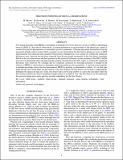| dc.contributor.author | Bzowski, M. | |
| dc.contributor.author | Kucharek, Harald | |
| dc.contributor.author | Heirtzler, D. | |
| dc.contributor.author | Schwadron, N. A. | |
| dc.contributor.author | Clark, G. | |
| dc.contributor.author | Fuselier, S. A. | |
| dc.contributor.author | McComas, David J. | |
| dc.contributor.author | Crew, Geoffrey B. | |
| dc.contributor.author | Mobius, Eberhard | |
| dc.contributor.author | Hlond, M. | |
| dc.contributor.author | O'Neill, M. E. | |
| dc.date.accessioned | 2015-02-25T16:07:23Z | |
| dc.date.available | 2015-02-25T16:07:23Z | |
| dc.date.issued | 2012-01 | |
| dc.date.submitted | 2011-07 | |
| dc.identifier.issn | 0067-0049 | |
| dc.identifier.issn | 1538-4365 | |
| dc.identifier.uri | http://hdl.handle.net/1721.1/95513 | |
| dc.description.abstract | Post-launch boresight of the IBEX-Lo instrument on board the Interstellar Boundary Explorer (IBEX) is determined based on IBEX-Lo Star Sensor observations. Accurate information on the boresight of the neutral gas camera is essential for precise determination of interstellar gas flow parameters. Utilizing spin-phase information from the spacecraft attitude control system (ACS), positions of stars observed by the Star Sensor during two years of IBEX measurements were analyzed and compared with positions obtained from a star catalog. No statistically significant differences were observed beyond those expected from the pre-launch uncertainty in the Star Sensor mounting. Based on the star observations and their positions in the spacecraft reference system, pointing of the IBEX satellite spin axis was determined and compared with the pointing obtained from the ACS. Again, no statistically significant deviations were observed. We conclude that no systematic correction for boresight geometry is needed in the analysis of IBEX-Lo observations to determine neutral interstellar gas flow properties. A stack-up of uncertainties in attitude knowledge shows that the instantaneous IBEX-Lo pointing is determined to within ~0[° over .]1 in both spin angle and elevation using either the Star Sensor or the ACS. Further, the Star Sensor can be used to independently determine the spacecraft spin axis. Thus, Star Sensor data can be used reliably to correct the spin phase when the Star Tracker (used by the ACS) is disabled by bright objects in its field of view. The Star Sensor can also determine the spin axis during most orbits and thus provides redundancy for the Star Tracker. | en_US |
| dc.language.iso | en_US | |
| dc.publisher | IOP Publishing | en_US |
| dc.relation.isversionof | http://dx.doi.org/10.1088/0067-0049/198/2/9 | en_US |
| dc.rights | Article is made available in accordance with the publisher's policy and may be subject to US copyright law. Please refer to the publisher's site for terms of use. | en_US |
| dc.source | American Astronomical Society | en_US |
| dc.title | PRECISION POINTING OF IBEX-Lo OBSERVATIONS | en_US |
| dc.type | Article | en_US |
| dc.identifier.citation | Hlond, M., M. Bzowski, E. Mobius, H. Kucharek, D. Heirtzler, N. A. Schwadron, M. E. O’Neill, et al. “PRECISION POINTING OF IBEX-Lo OBSERVATIONS.” The Astrophysical Journal Supplement Series 198, no. 2 (January 31, 2012): 9. © 2012 The American Astronomical Society | en_US |
| dc.contributor.department | Haystack Observatory | en_US |
| dc.contributor.mitauthor | Crew, Geoffrey B. | en_US |
| dc.relation.journal | The Astrophysical Journal. Supplement Series | en_US |
| dc.eprint.version | Final published version | en_US |
| dc.type.uri | http://purl.org/eprint/type/JournalArticle | en_US |
| eprint.status | http://purl.org/eprint/status/PeerReviewed | en_US |
| dspace.orderedauthors | Hlond, M.; Bzowski, M.; Mobius, E.; Kucharek, H.; Heirtzler, D.; Schwadron, N. A.; O'Neill, M. E.; Clark, G.; Crew, G. B.; Fuselier, S.; McComas, D. J. | en_US |
| mit.license | PUBLISHER_POLICY | en_US |
| mit.metadata.status | Complete | |
